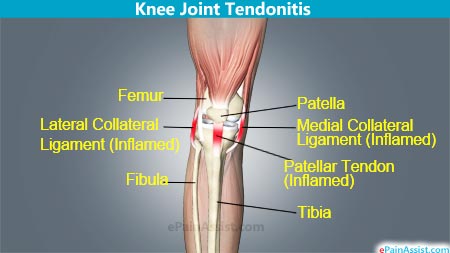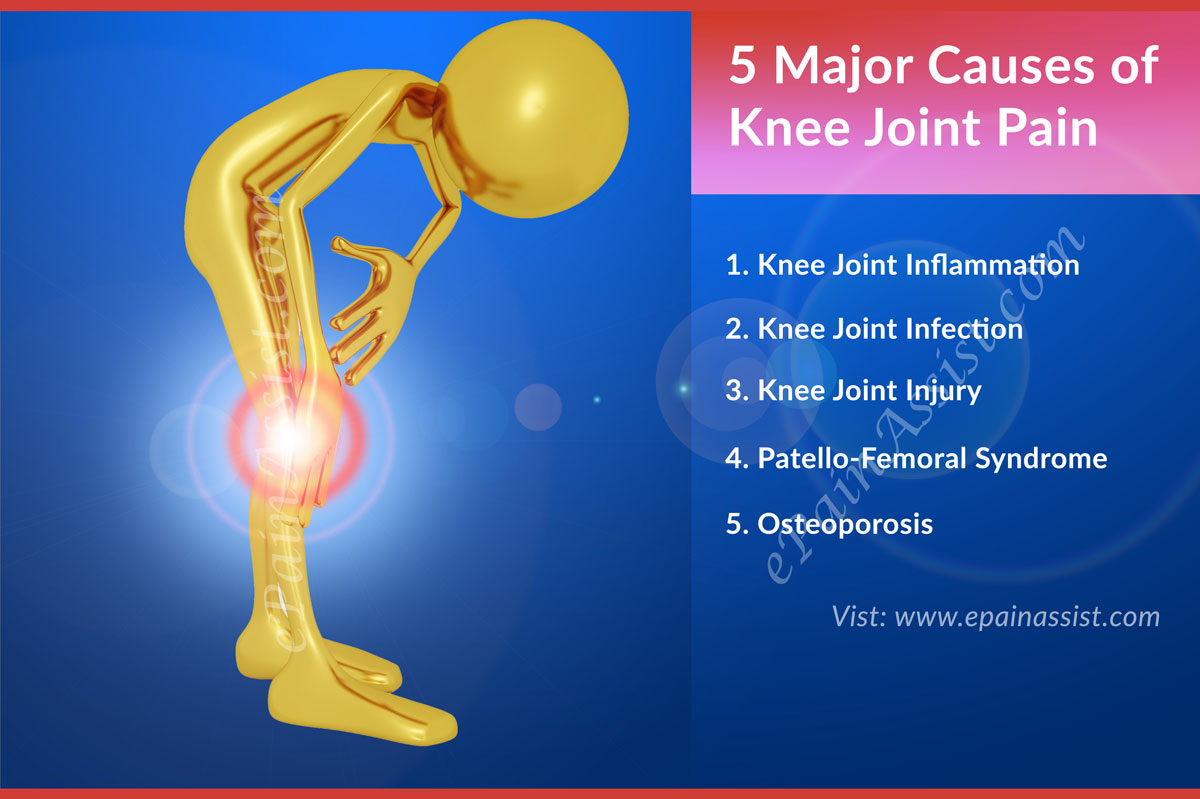Knee joint is the largest joint in human body.1 Knee joint links lower leg with thigh. Knee joint participates in weight transmission during standing position or while jogging. Knee joint pain is caused by inflammation, infection or injury of the knee joint.
Causes of Knee Joint Injury
- Auto Accident
- Work Accident
- Slip or Fall
- Domestic Accident
5 Major Causes of Knee Joint Pain
1. Knee Joint Inflammation
- Inflammation of Joint and Cartilage- Arthritis 2
- Inflammation of Tendon- Tendonitis
- Inflammation of Bursa- Bursitis
- Inflammation of Synovial Membrane
- Inflammation of Ligaments- Ligamental Inflammation
2. Knee Joint Infection
- Blood Borne 3
- Caused by Penetrating Wound
3. Knee Joint Injury
- Ligamental Sprain
- Tendon Rupture or Tear
- Torn Meniscus
- Fragments in Knee Joint
- Knee Joint Dislocation
- Knee Joint Fracture
4. Patello-Femoral Syndrome
5. Osteoporosis
1. Inflammation of Joint and Cartilage-
A. Arthritis of the Knee Joint
a. Osteoarthritis
- Osteoarthritis is a degenerative disease.
- Causes cartilage damage and thinning of cartilages.
- Osteophytes and hypertrophy of tibia and femur observed in later stage.
- Results in joint deformity.
b. Rheumatoid Arthritis
- Autoimmune disease
- Causes inflammation of synovial membrane and capsule
- Inflammation causes excessive secretion of synovial fluid resulting in joint swelling
- Joint effusion (swelling by excessive fluid) causes joint deformity and may result in joint subluxation.

Watch 3D Video of Knee Pain Due to Rheumatoid Arthritis
c. Psoriatic Arthritis
- Associated with psoriatic skin disease
- Inflammatory joint disease results in inflammation of synovial membrane and ligaments.
- Degeneration of articulating cartilages and menisci.

d. Gout
- Knee joint swelling is caused by inflammation of synovial membrane, capsule, ligaments and tendon.
- Soft tissue inflammation results from irritation of tissue following uric acid deposits.
- Uric acid deposits in knee joint causes inflammation and edema of articular cartilage and menisci.

e. Pseudogout 4
- Knee joint swelling is caused by soft tissue inflammation
- Soft tissue inflammation (synovial membrane, tendon and ligaments) results from irritation of tissue following calcium deposits
- Calcium deposits in knee joint causes inflammation and edema of articular cartilage and menisci.
B. Tendonitis of Knee Joint
- Inflammation of tendon is known as tendonitis.
- Tendonitis is caused by overuse of the muscles and tendon.
- Tendonitis follows injury or trauma of the tendon and muscles.
- Tendonitis of superior patellar tendon is known as Osgood-Schlatter Disease.
- Osgood-Schlatter tendonitis is caused by overuse, irritation or injury of the knee cap and patellar tendon.
- Inflammation of patellar tendon below patella is known as ”jumper’s knee.”

C. Bursitis of Knee Joint
- Bursitis is caused by inflammation of bursa.
- Inflammation often follows trauma.
- Bursitis causes increased secretion of viscous fluid, which is collected in a sac.
- Most common knee joint bursitis is Housemaid Knee and Baker’s Cyst.
- Pre-patellar bursa is known as ”Housemaid’s knee” is also known as ”Preacher’s Knee” and is caused by kneeling on knee often for prolonged time.
- A ”Baker’s cyst” is inflammation of popliteal bursa and causes swelling of sac at the back of the knee.

D. Inflammation of Synovial Membrane
- Common with Rheumatoid Arthritis.
- Isolated knee joint synovial membrane inflammation is rare.
- “Synovial Plica Syndrome” is inflammation of an extension of synovial capsule or synovial pocket in the knee joint.
E. Inflammation of Knee Joint Ligament
- Isolated inflammation of knee joint ligament is rare.
- Ligament inflammation follows injury of the ligament or knee joint infection.
2. Infection of Knee Joint
- Knee Joint infection is also known as Septic Arthritis.
- Results in Knee Joint Abscess.
- Follows severe deterioration and atrophy of the cartilages and synovial membrane.
- Often follows penetrating injury.
- Blood borne bacterial infection transmitted from distant source of infection or abscess by blood.
3. Injury of Knee Joint
A. Ligamental Sprain
- Grade 1- Laceration or forceful stretch of ligament.
- Grade 2- Partial tear of the ligament.
- Grade 3- Complete tear of the ligament.
Common Ligamental Injury-
- Anterior Cruciate Ligament Tear
- Posterior Cruciate Ligament Tear
- Medial Collateral Ligament Tear
- Lateral Collateral Ligament Tear
B. Tendon Rupture or Tear
- Grade 1- Laceration or forceful stretch of tendon
- Grade 2- Partial tear of the tendon
- Grade 3- Complete tear of the tendon
C. Torn Meniscus
- Meniscus tear may be partial or complete.
- Tear may be associated with cartilage fragments in the joint resulting in severe pain with joint movements.
- Tear is caused by continuous wear and tear of the joint known as “Degenerative Tear”.
- Meniscus tear mostly results from knee joint injuries.

D. Fragments in Knee Joint
- Fragments are pieces of bone and cartilages spilled into the knee joints.
- Fragments may be torn ligaments in degenerative knee joint disease.
- Bone or cartilage fragments cause pain and frozen knee joint.
- Fragments can be a result of severe osteoarthritis, rheumatoid arthritis, and fracture of knee joint.

F. Knee Joint Dislocation
- Very uncommon injury
- Mostly caused by auto accident or fall from heights.
- Severe pain and inability to move knee joint.

G. Knee Joint Fracture
- Involves femur, tibia, patella or fibula.
- Fracture of patella is the most common knee joint fracture observed following injury.
- Patellar fracture is also common in patient suffering with osteoporosis
- Mostly caused by auto accident or fall from heights.
- Severe pain and inability to move knee joint.

4. Patello-Femoral Syndrome
- The condition is caused by irritation or inflammation of articulation surface of patella and femur.
- Irritation is caused by abnormal or shearing forces generated by tendon and muscles attached to patella.
- The inflammation or wear and tear of the articulating cartilage between femur and patella causes severe pain known as Patello-Femoral Syndrome.
- Thinning and softening of the cartilage is also known as Chondromalacia.
- Patello-Femoral Syndrome is often associated with dislocation or fracture of knee joint.
5. Osteoporosis
- Osteoporosis is a metabolic disorder that results in demineralization of bone because of loss of calcium.
- Bone becomes weak and brittle.
- Osteoporotic bones easily fractures following severe cough or even sneezing.
Also Read:
- Knee Joint Fracture: Classification, Types, Causes, Symptoms, Signs, Treatment, Surgery
- Rehab, PT, Exercises Following Knee Surgery & Knee Injury
- Knee Joint Bruises: Causes, Symptoms, Treatment, Recovery, Prevention
- Knee Joint Pain: A Complete Treatment Guide- Conservative, Medications, PT, Surgery
- Knee Joint Abscess: Causes, Symptoms, Treatment, Prognosis
- Understanding Knee Joint, Its Structure, 6 Causes of Knee Joint Pain
- Knee Joint Tendonitis: Types, Symptoms, Treatment- Conservative, NSAIDs, PT, Surgery
- Knee Joint Anatomy: Bones, Cartilages, Muscles, Ligaments, Tendons-Quadriceps

